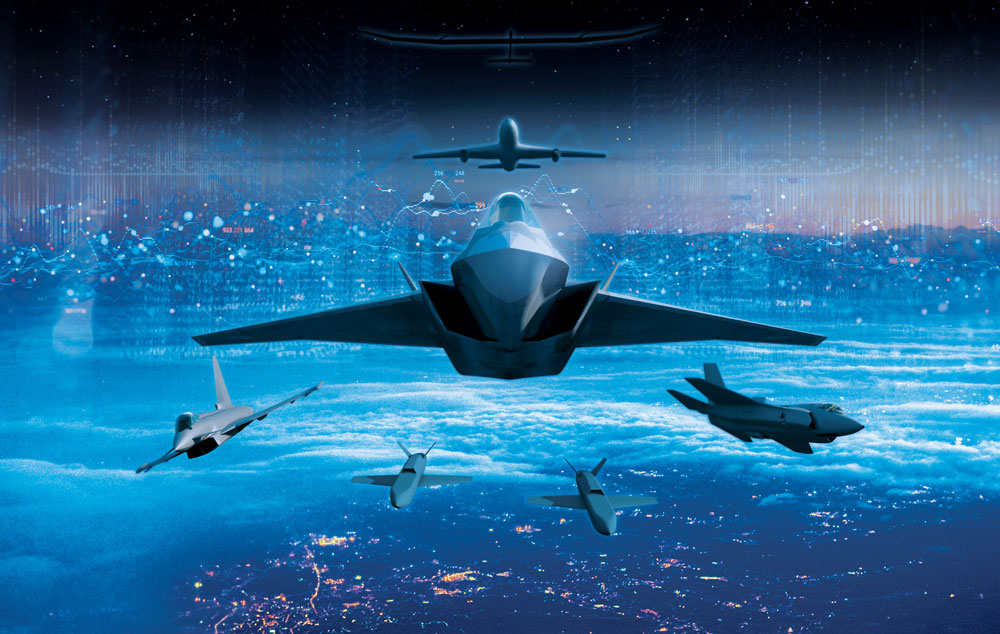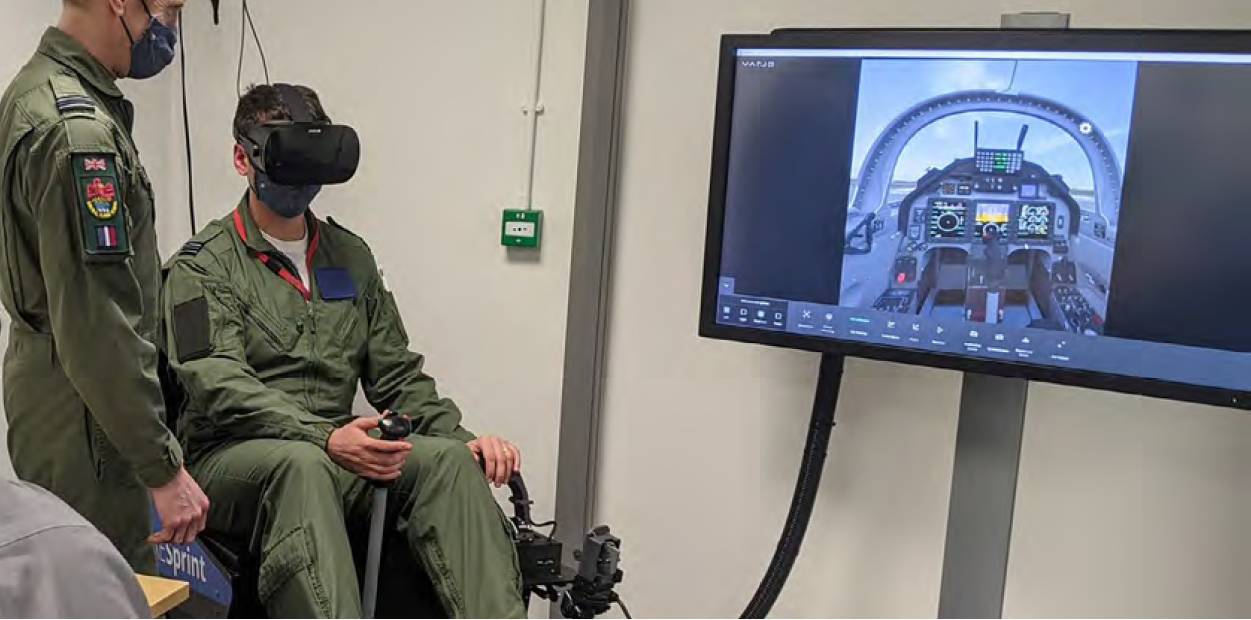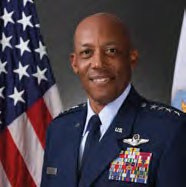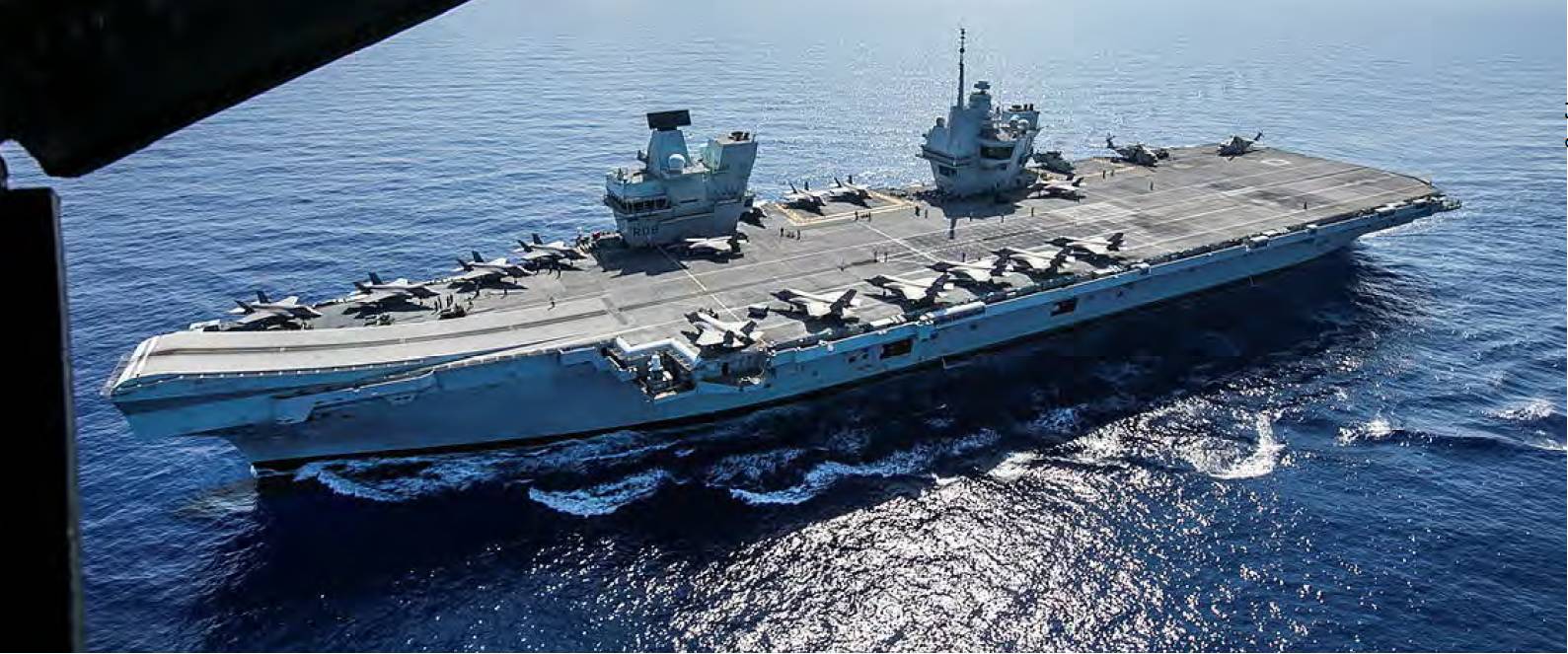DEFENCE Global Air Chiefs Conference report
The air force of 2040
synthetically-trained, cloud networked, space-enabled and net zero?
TIM ROBINSON FRAeS reports from the RAF Global Air Chiefs Conference held as a blended virtual/live event in July, which saw high-level military and civilian speakers come together to debate and discuss the future of air and space power.
 BAE Systems
BAE Systems
Back in 2021 with a new name and this year organised as a hybrid live/virtual event due to Covid-19 restrictions, the RAF Global Air Chiefs Conference once again was a must-attend global forum for air and space power professionals and for those interested in the wider future of armed conflict, technology and society.
The conference speakers ranged from UK Minister of the Armed Forces, James Heappey MP, to air chiefs (RAF Chief of the Air Staff ACM Sir Mike Wigston and USAF Chief Gen Charles Q Brown), space commanders (Gen ‘Jay’ Raymond, US Space Force and AVM Paul Godfrey, UK Space Command), as well as academics, industry executives and more. It was also notable as the first RAF air and space power conference after the Integrated Review, which saw winners in R&D for Tempest, drones and and space, at arguably the expense of airlift and aggressors – as well as capability gap between the retirement of the E-3D Sentry and the introduction of the E-7A Wedgetail.
With the theme of ‘the air and space force of 2040’ the one-day conference, organised by the Air and Space Power Association, was packed with fascinating and thought-provoking sessions – from China’s use of UAVs on the Indian border to ‘probe’ defences in a sub-threshold way, to the RAF’s ambitious plans to decarbonise and go ‘net zero’ by 2040 – blazing a trail to more sustainable air power. Space power too, is now deeply embedded in the fabric of these conferences as the natural extension of air forces that exploit speed, reach and surveillance – while a briefing from eVTOL developer Vertical Aerospace, showed how the urban air mobility sector is accelerating technology in batteries, FBW and advanced composites.
Covering all these headlines and presentations would thus be impossible in such a short summary but two of the most intriguing were synthetic training and multi-domain combat clouds.
How far can virtual training go?
One of the noteworthy headlines from GACC was the vision from the RAF ACM Chief Sir Mike Wigston of a move to mostly virtual training with him saying: “I do not exaggerate when I say that I can see a future where almost all training, force generation, and mission planning and rehearsal is done in a synthetic environment, preserving our real world activity for live operations or strategic signalling.”
 ACM Sir Mike Wigston, Chief of Air Staff (MoD)There are a number of compelling reasons for this. The first is that the fidelity of modern flight simulators has now improved immeasurably, while costs have dropped. Consumer sims, such as DCS World and MSFS, have arguably outpaced professional military simulations in some areas and, when coupled with VR, can immerse the student in the world – rectifying the limitations of small desktop monitors.
ACM Sir Mike Wigston, Chief of Air Staff (MoD)There are a number of compelling reasons for this. The first is that the fidelity of modern flight simulators has now improved immeasurably, while costs have dropped. Consumer sims, such as DCS World and MSFS, have arguably outpaced professional military simulations in some areas and, when coupled with VR, can immerse the student in the world – rectifying the limitations of small desktop monitors.
The second is that that modern aircraft, such as Typhoon, A400M and F-35, have become, thanks to fly-by-wire and automation, far easier to fly than the warplanes of the past. The learning then, has shifted from training someone to fly the aeroplane with stick and rudder skills to being able to ‘fight it’ as a battlespace manager – and that arguably could be performed better in a simulation where multiple enemies and friendly forces can be generated – putting them in large-scale virtual war games.
Another reason for the shift to virtual training and mission rehearsal is that of keeping tactics and procedures secret and away from prying eyes and ears. Stealth capabilities, advanced radar modes and accurate weapon ranges can all be practised and trained fully in classified and secure simulations. The rise of ‘peer nation threats’ and the potential breakthroughs in capabilities, such as ‘Loyal Wingman’, swarming drones and AI, means that testing and rehearsing these tactics in the open could tip the enemy’s hand and allow them C to develop countermeasures, technology or tactics to negate these when fielded in battle.
I DO NOT EXAGGERATE WHEN I SAY THAT I CAN SEE A FUTURE WHERE ALMOST ALL TRAINING, FORCE GENERATION, AND MISSION PLANNING AND REHEARSAL IS DONE IN A SYNTHETIC ENVIRONMENT.
ACM Sir Mike Wigston
Chief of the Air Staff, Royal Air Force
Additionally, with long-range weapon missiles, hypersonics and space systems, even the vast ranges that the US enjoys in Nevada are now becoming too small to practise the kind of multi-domain warfare that may dominate the 21st Century. In synthetics – there is no worry about airspace size, deconfliction with civil traffic, sorties cancelled due to weather or noise complaints from low-level flying.
To that end, at GACC, Wigston revealed that the RAF’s new distributed flight simulation system, Gladiator, would be inititally operational by the end of this year – and would also be extended with a £40m investment from the Typhoon to include other RAF and UK platforms, such at the E-7A Wedgetail, Protector and even the Type 45 destroyer, allowing large-scale virtual training to take place. Interestingly, it would also be linked to the NEXUS combat cloud (see picture below).
However, not all are convinced of this shift to synthetics – arguing that it is Treasury-led in an attempt to cut flying hour costs, rather than improve combat effectiveness and produce more skilled aircrew.
Surprisingly, USAF Chief General Charles Q Brown was also skeptical of this wholesale shift to virtual training, telling a defence media roundtable immediately after the conference that, while synthetic training “may speed up the learning curve” and offered opportunities because the “technology can support it”, he cautioned: “I think our aircrew have to get airborne. There’s an aspect of actually not only getting airborne but it’s also for our maintainers. You can’t fix an airplane if it doesn’t fly and break and understand that aspect.”
He went on: “By using synthetic, it does maybe save you some money in operating costs but, at the same time, there is a balance between that operating cost and the readiness of our aircrew and the support functions that maintain our aircraft and our supply chain to have a good understanding of how all that comes together.”
 RAF students are now trialing Sprint VR flight training devices from CAE as part of MFTS. CAE
RAF students are now trialing Sprint VR flight training devices from CAE as part of MFTS. CAE
Air forces in 2040 – operating in a world of zettabytes
Another headline topic at the conference was that of an increasingly connected and networked battlespace – where seamless digital links connect sensors and shooters into one dynamic cloud or ‘mesh’. This Revolution in Military Affairs (RMA) has been predicted before and never arrived but now the combination of big data, faster computers and more bandwidth is making this a reality.
 Gen Charles Q Brown, Chief of Staff of Air Force, USAF (USAF)Indeed, speaking at the conference, Professor Julia Sutcliffe, Chief Technologist and Director Air Lab, BAE Systems gave a jaw-dropping comparison of future data demands when she noted that a Eurofighter Typhoon today: “Operates in the world of terabytes – so, if one grain of rice is a byte, Typhoon generates a container’s worth of rice over a number of sorties. But, in the multi-domain world of 2040, systems will be operating in the world of zettabytes–enough rice to fill the Pacific Ocean”.
Gen Charles Q Brown, Chief of Staff of Air Force, USAF (USAF)Indeed, speaking at the conference, Professor Julia Sutcliffe, Chief Technologist and Director Air Lab, BAE Systems gave a jaw-dropping comparison of future data demands when she noted that a Eurofighter Typhoon today: “Operates in the world of terabytes – so, if one grain of rice is a byte, Typhoon generates a container’s worth of rice over a number of sorties. But, in the multi-domain world of 2040, systems will be operating in the world of zettabytes–enough rice to fill the Pacific Ocean”.
This vision of big-data-enabled warfare is now getting closer and ACM Wigston revealed that the RAF’s Combat Cloud, NEXUS, is ready to be fielded, saying: “We are now at the point where our combat cloud called NEXUS can begin to be introduced operationally. It is flexible, secure, proven and we have developed it in-house at a fraction of the cost of comparators.”
This software, which can run on computers, laptops or even smartphones and which was coded ‘in-house’, takes data from a wide variety of sources and ‘tags’ it to be disseminated further around the battlespace. Explained Wigston: “In one recent evaluation, we hand-carried the system onboard one of our Voyager aircraft. Once airborne, laptops and tablets were configured to show a real-time Common Operating Picture constructed from data ingested into a ground-based NEXUS node from a variety of information feeds. This was a functioning C2 network configured at 25,000ft in just 15 minutes.”
MY INTENT IS TO MAKE SURE WE, IN EVERYTHING WE DO, THINK ABOUT OUR ALLIES AND PARTNERS
Gen Charles Q Brown
Chief of Staff of the Air Force, United States Air Force
Significant in the roll-out of this long-awaited multi-domain Combat Cloud is that it was developed in-house by RAF software coders – perhaps a preview of where air forces in 2040 may be heading – where software coders and cyber hackers may outnumber traditional ‘riggers’ or airframe technicians.
The USAF, meanwhile, is going even further with its ABMS (Advanced Battle Management System) which seeks to automate and accelerate the ‘kill-chain’, allowing AI to hand-off targets found by sensor platforms to the most appropriate shooter – whether they are airborne, surface or even subsurface. Fully realised, this potentially could mean an infantry squad corporal tasking a nearby B-21 stealth bomber to use precision munitions to remove an enemy bunker – without a joint terminal attack controller (JTAC) or combined air operations centre (CAOC) manually approving the strike. A human, though, would still make the final decision to kill.
 Will the USAF’s focus on expensive longer range platforms, like the B-21 Raider, optimised for the Indo-Pacific decouple it from European requirements? USAF
Will the USAF’s focus on expensive longer range platforms, like the B-21 Raider, optimised for the Indo-Pacific decouple it from European requirements? USAF
Could the USAF leave allies behind?
However, this vision of high-speed, connected warfare and the US’s pivot to Asia-Pacific also raises its own challenges to partners – according to a presentation by Justin Bronk, RUSI Air Power Research Fellow, who observed the vulnerability of the West’s HVA (high-value assets), such as E-3D AWACS, Rivet Joint and tankers, to threat nations will push these ‘enablers’ further away from any front line.
Bronk argued that large, expensive, longer-ranged platforms, such as the B-21, NGAD and MQ-25, optimised for US needs in Indo-Pacific then could decouple the USAF from its partner air forces particularly in Europe, which may be unable to afford these aircraft in large numbers. “All of these systems would make the [combat/mass] problem worse not better for European air forces,” he said.
Beyond hardware, Bronk said the: “C2 is the most important change we are going to see”. He said that the US shift to ‘Uber-like sensor-shooter matchings’ could also see partners potentially face a ‘significantly tricky choice’ – either invest in keeping pace and fitting in with highly automated US combat cloud networks or face potentially being left behind and being unable to plug into this American combat web.
These networks require a deeper and more complex co-operation than say Link 16, encrypted radios or liaison officers in CAOCs for allies. Bronk thus concluded that a European alternative to the US ABMS may be needed and that Europe needed to start thinking about it now. However, questioned on this by AEROSPACE, USAF chief Gen Brown was cognisant of the challenge to bring allies and partners along on this path – especially when some allies may ask where their ‘Red Card’ might be in coalition operations in such a high-speed network. These ‘Red Cards’ allow coalition partners to be embedded in US command chain, yet give them a veto if they feel that rule of engagement or legal guidelines are not being followed.
Gen Brown said: “When you look at the ABMS, it’s how we connect but it’s really about data. It’s how we move data and how we move information to make decisions. Part of our dialogue internal in the USAF but also, as you look at joint all-domain and command-and-control, or combined joint all-domain command-and-control, is how we bring in our allies and partners.” He explained: “It’s important that we are in good dialogue with our partners so we do not leave them behind, because that’s not my intent. My intent is to make sure we, in everything we do, think about our allies and partners,” adding: “Now, on the aspect of a Red Card, this is something we’re going to have to work through. It’s not just the technology aspect of this; it’s really our processes that we have to think about and we have to think about them differently.
I think decisions will happen at a much higher rate of speed because all of the information and how we are able to use our technology. This is something that was discussed at the Global Air Chiefs’ Conference that we might have to do these things differently and it may be an algorithm that helps us be able to determine that. I don’t know that that’s the answer but it’s something we’ve got to think about and we may have to do it differently than we do today.”
 ‘Confident, not confrontational’, according to the UK MoD, HMS Queen Elizabeth sends a message that Britain is back on the global stage. Crown copyright/MoD
‘Confident, not confrontational’, according to the UK MoD, HMS Queen Elizabeth sends a message that Britain is back on the global stage. Crown copyright/MoD
Summary
In his opening address, ACM Wigston said there are three themes to come out of the Integrated Review and what it means for UK defence: “Firstly, the uncertain, complex and dynamic international context, with fast-evolving threats becoming ever more sophisticated and proliferating widely. Secondly, in this era of chronic instability, a UK prepared and able to act on the world stage as a problem-solving, burden-sharing nation, amplifying our influence through deeper relationships and partnerships. Thirdly, that this government could not be clearer in its view of the integral role of the UK armed forces in UK national power. As those themes played out over the last year, the Royal Air Force position was very clear: air and space power gives our government the choice and ability to act and signal strategically on a global stage, at range, at speed, precisely, with minimal political risk and maximum political choice.”
This last point of ‘acting on a global stage’ is currently being demonstrated by the hard military power of HMS Queen Elizabeth, CSG21 and its embarked RAF/RN and USMC air wing – the biggest yet deployment of fifth-generation air power at sea.
Thus, despite the topics of NetZero, diversity and other wider social issues, these years GACC also had a underlying hard-edged feel to it – with Minister of State for Armed Forces, James Heappey MP, telling the Chief of the Air Staff that his first task is: ‘Win the fight”, This reflects the changing and deteriorating international landscape – with challenges across all domains from cyber to space.
Indeed, post-conference, the announcement that the RAF would be practicing dispersed operations for the first time in three decades, is a market that, despite the feel-good headlines around ‘battle braids’ hair regulations and NetZero green goals, there is a refreshed and rebooted Cold War-esque focus on surviving, adapting and winning any fight against the toughest adversary.
 BAE Systems
BAE Systems ACM Sir Mike Wigston, Chief of Air Staff (MoD)There are a number of compelling reasons for this. The first is that the fidelity of modern flight simulators has now improved immeasurably, while costs have dropped. Consumer sims, such as DCS World and MSFS, have arguably outpaced professional military simulations in some areas and, when coupled with VR, can immerse the student in the world – rectifying the limitations of small desktop monitors.
ACM Sir Mike Wigston, Chief of Air Staff (MoD)There are a number of compelling reasons for this. The first is that the fidelity of modern flight simulators has now improved immeasurably, while costs have dropped. Consumer sims, such as DCS World and MSFS, have arguably outpaced professional military simulations in some areas and, when coupled with VR, can immerse the student in the world – rectifying the limitations of small desktop monitors. RAF students are now trialing Sprint VR flight training devices from CAE as part of MFTS. CAE
RAF students are now trialing Sprint VR flight training devices from CAE as part of MFTS. CAE Gen Charles Q Brown, Chief of Staff of Air Force, USAF (USAF)Indeed, speaking at the conference, Professor Julia Sutcliffe, Chief Technologist and Director Air Lab, BAE Systems gave a jaw-dropping comparison of future data demands when she noted that a Eurofighter Typhoon today: “Operates in the world of terabytes – so, if one grain of rice is a byte, Typhoon generates a container’s worth of rice over a number of sorties. But, in the multi-domain world of 2040, systems will be operating in the world of zettabytes–enough rice to fill the Pacific Ocean”.
Gen Charles Q Brown, Chief of Staff of Air Force, USAF (USAF)Indeed, speaking at the conference, Professor Julia Sutcliffe, Chief Technologist and Director Air Lab, BAE Systems gave a jaw-dropping comparison of future data demands when she noted that a Eurofighter Typhoon today: “Operates in the world of terabytes – so, if one grain of rice is a byte, Typhoon generates a container’s worth of rice over a number of sorties. But, in the multi-domain world of 2040, systems will be operating in the world of zettabytes–enough rice to fill the Pacific Ocean”.
